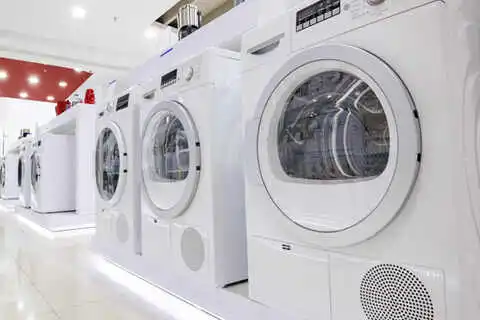
Spin Extractors and Washing Machines

Washing machine and spin extractor standards define safety guidelines for household and commercial washing, and describe methods for measuring performance and efficiency. These standards serve to establish technical and safety specifications for domestic and commercial use. This selection of standards applies to appliances with single-phase voltages of under 250 volts or 480 volts for other appliances.
IEC 60335-2-4 Ed. 7.0 b:2021
Household and similar electrical appliances - Safety - Part 2-4: Particular requirements for spin extractors
IEC 60335-2-4:2021 is available as IEC 60335-2-4:2021 RLV which contains the International Standard and its Redline version, showing all changes of the technical content compared to the previous edition. IEC 60335-2-4:2021 deals with the safety of stand-alone electric spin extractors and spin extractors incorporated in washing machines that have separate containers for washing and spin extraction for household and similar purposes that have a capacity not exceeding 10 kg of dry cloth and a drum peripheral speed not exceeding 50 m/s, their rated voltages being not more than 250 V for single-phase appliances and 480 V for other appliances. Appliances not intended for normal household use but which nevertheless may be a source of danger to the public, such as spin extractors intended to be used by laymen in shops, in light industry and on farms, and spin extractors for communal use in blocks of flats or in launderettes, are within the scope of this standard. As far as is practicable, this standard deals with the common hazards presented by appliances which are encountered by all persons in and around the home. Attention is drawn to the fact that: - for appliances intended to be used in vehicles or on board ships or aircraft, additional requirements can be necessary; - in many countries, additional requirements are specified by the national health authorities, the national authorities responsible for the protection of labour, the national water supply authorities and similar authorities. This standard does not apply to: - appliances intended exclusively for industrial purposes; - appliances intended to be used in locations where special conditions prevail, such as the presence of a corrosive or explosive atmosphere (dust, vapour or gas). This seventh edition cancels and replaces the sixth edition published in 2008, Amendment 1:2012 and Amendment 2:2017. This edition constitutes a technical revision. This edition includes the following significant technical changes with respect to the previous edition: - aligns the text with IEC 60335-1, Ed 5, and its Amendments 1 and 2; - replacement of the term definition of accessible part to include test probe 18; - addition of test probe 18 for accessibility of live parts. This part 2 is to be used in conjunction with the fifth edition of IEC 60335-1:2010 and its amendments.

IEC 60335-2-4 Ed. 6.1 b:2012
Household and similar electrical appliances - Safety - Part 2-4:Particular requirements for spin extractors
IEC 60335-2-4:2008+A1:2012 deals with the safety of spin extractorsincorporated in washing machines that have separate containers for washing and spin extraction for household and similar purposes that have a capacity not exceeding 10 kg of dry cloth and a drum peripheral speed not exceeding 50 m/s, their rated voltages being not more than 250 V for single-phase appliances and 480 V for other appliances. The principal changes in the this edition as compared with the fifth edition of IEC 60335-2-4 are as follows: aligns the text with 60335-1:2001, and its Amendments 1 clarifies criteria for the protection against mechanical hazards for double lid appliances (20.103 and 20.104); some notes have been converted to normative text (clause 1, 20.102 and Annex AA). This consolidated version consists of the sixth edition (2008) and its amendment 1 (2012). Therefore, no need to order amendment in addition to this publication. This publication is to be read in conjunction with IEC 60335-1:2010 .
IEC 60335-2-7 Ed. 8.0 b:2019
Household and similar electrical appliances - Safety - Part 2-7: Particular requirements for washing machines
IEC 60335-2-7:2019 is available as IEC 60335-2-7:2019 RLV which contains the International Standard and its Redline version, showing all changes of the technical content compared to the previous edition. IEC 60335-2-7:2019 deals with the safety of electric washing machines for household and similar use, that are intended for washing clothes and textiles, their rated voltage being not more than 250 V for single-phase appliances and 480 V for other appliances. This standard also deals with the safety of electric washing machines for household and similar use employing an electrolyte instead of detergent. Additional requirements for these appliances are given in Annex CC. Guidance is given in Annex DD for requirements that can be used to ensure an acceptable level of protection against electrical and thermal hazards for washing machines fitted with a power driven wringer. Appliances not intended for normal household use but which nevertheless may be a source of danger to the public, such as appliances intended to be used by laymen in shops, in light industry and on farms, are within the scope of this standard. Examples of such appliances are washing machines for communal use in blocks of flats or in launderettes. As far as is practicable, this standard deals with the common hazards presented by washing machines that are encountered by all persons in and around the home. However, in general, it does not take into account: – persons (including children) whose physical, sensory or mental capabilities or lack of experience and knowledge prevents them from using the appliance safely without supervision or instruction; – children playing with the appliance. Attention is drawn to the fact that: – for washing machines intended to be used in vehicles or on board ships or aircraft, additional requirements may be necessary; – in many countries additional requirements are specified by the national health authorities, the national authorities responsible for the protection of labour, the national water supply authorities and similar authorities. This standard does not apply to: – washing machines intended exclusively for industrial purposes (ISO 10472-2); – appliances intended to be used in locations where special conditions prevail, such as the presence of a corrosive or explosive atmosphere (dust, vapour or gas); – washing machines incorporating steam generating devices in which steam is produced at a pressure exceeding 50 kPa. This eighth edition cancels and replaces the seventh edition published in 2008, Amendment 1: 2011 and Amendment 2:2016. This edition constitutes a technical revision. This edition includes the following significant technical changes with respect to the previous edition: – requirements for steam generators in 3.1.9, 3.6.101, 19.101, 22.106, 22.107; – additional definitions for washing machine types in 3.5.101,3.5.102, 3.5.103; – revised temperature limits for external accessible surfaces in 11.3 and 11.8; – revised test procedure for the spillage test in 15.2; – additional requirements for appliances that are controlled by programmable electronic circuits that limit the number of heating elements and motors from being energised at the same time, Subclause 22.108. This part 2 is to be used in conjunction with the latest edition of IEC 60335-1 and its amendments. It was established on the basis of the fifth edition (2010) of that standard.

IEC 60335-2-7 Ed. 7.1 b:2012
Household and similar electrical appliances - Safety - Part 2-7: Particular requirements for washing machines
"IEC 60335-2-7:2008+A1:2011 deals with the safety of electric washing machines for household and similar use, that are intended for washing clothes and textiles, their rated voltage being not more than 250 V for single-phase appliances and 480 V for other appliances. This standard also deals with the safety of electric washing machines for household and similar use employing an electrolyte instead of detergent. Additional requirements for these appliances are given in Annex CC. This publication is to be read in conjunction with IEC 60335-1:2010 . This consolidated version consists of the seventh edition (2008) and its amendment 1 (2011). Therefore, no need to order amendment in addition to this publication. "
IEC 60704-2-4 Ed. 3.0 b:2011
Household and similar electrical appliances - Test code for the determination of airborne acoustical noise - Part 2-4: Particular requirements for washing machines and spin extractors
"IEC 60704-2-4:2011 These particular requirements apply to single unit electrical washing machines and the washing and spinning function of combined appliances for household and similar use and to spin extractors for household and similar use. This third edition cancels and replaces the second edition (2001). Main changes are: - measurement uncertainty and standard deviations are taken into account, - definitions of standard test load and standard test program are modified, - test enclosure was replaced by common test enclosure defined in Part 1 and - information to be reported is modified. This publication is to be read in conjunction with IEC 60704-1:2010 ."
IEC 60734 Ed. 4.0 b:2012
Household electrical appliances - Performance - Water for testing
IEC 60734:2012 describes the preparation of four types of water of different hardness, conductivity and alkalinity, intended to be used for testing the performance of household appliances such as washing machines, dishwashers, tumble dryers, steam irons etc. It defines the characteristics of these waters and establishes various methods to be used for obtaining them. It also includes specifications for required measurements.
